Comprehensive Report: Brand Management and Apple Inc. Strategies
VerifiedAdded on 2020/10/05
|23
|6945
|135
Report
AI Summary
This report delves into the critical aspects of brand management, using Apple Inc. as a primary case study. It begins with an introduction to branding, brand equity, and the significance of brand management in the modern business landscape. The report then analyzes Apple's brand portfolio strategy, examining how the company manages its diverse product lines, including the iPhone, and employs strategies like rebalancing, premium pricing, and sequential product management. It explores Apple's brand hierarchy, illustrating how its products are positioned within its overall brand structure. Furthermore, the report applies Aaker's brand equity model to assess brand loyalty, awareness, perceived quality, brand associations, and other proprietary assets. It also examines how marketing and branding contribute to consumer preferences, revenue generation, and market share. The report concludes by summarizing the importance of branding and its impact on an organization's success, emphasizing how effective brand management can lead to increased revenues, market shares, and customer loyalty. Finally, the report discusses various methods used to measure a brand's value, awareness, and consumer attitudes. This report provides a comprehensive overview of brand management principles and their practical application within a leading technology company.

BRAND MANAGEMENT
Paraphrase This Document
Need a fresh take? Get an instant paraphrase of this document with our AI Paraphraser
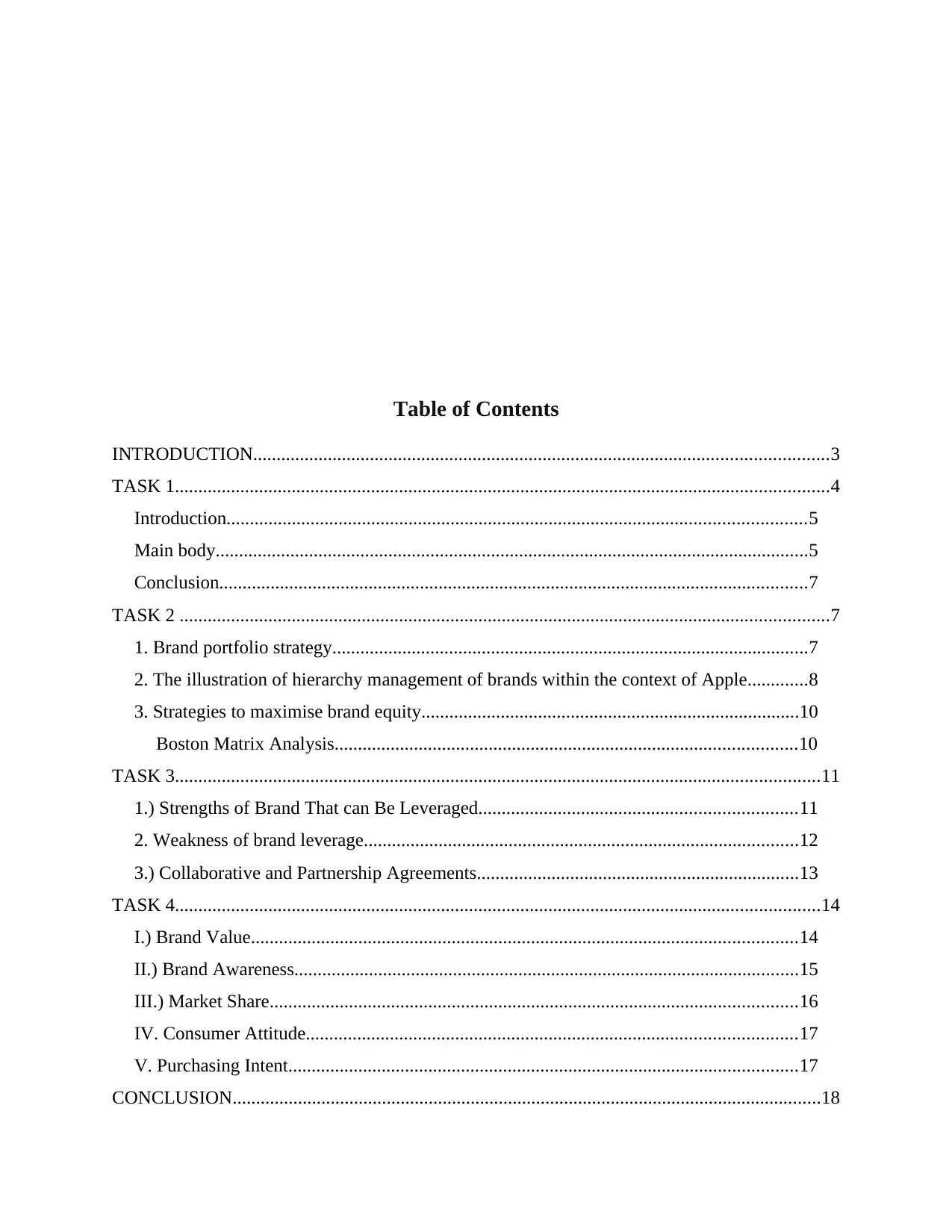
Table of Contents
INTRODUCTION...........................................................................................................................3
TASK 1............................................................................................................................................4
Introduction............................................................................................................................5
Main body...............................................................................................................................5
Conclusion..............................................................................................................................7
TASK 2 ...........................................................................................................................................7
1. Brand portfolio strategy......................................................................................................7
2. The illustration of hierarchy management of brands within the context of Apple.............8
3. Strategies to maximise brand equity.................................................................................10
Boston Matrix Analysis...................................................................................................10
TASK 3..........................................................................................................................................11
1.) Strengths of Brand That can Be Leveraged....................................................................11
2. Weakness of brand leverage.............................................................................................12
3.) Collaborative and Partnership Agreements.....................................................................13
TASK 4..........................................................................................................................................14
I.) Brand Value.....................................................................................................................14
II.) Brand Awareness............................................................................................................15
III.) Market Share.................................................................................................................16
IV. Consumer Attitude.........................................................................................................17
V. Purchasing Intent.............................................................................................................17
CONCLUSION..............................................................................................................................18
INTRODUCTION...........................................................................................................................3
TASK 1............................................................................................................................................4
Introduction............................................................................................................................5
Main body...............................................................................................................................5
Conclusion..............................................................................................................................7
TASK 2 ...........................................................................................................................................7
1. Brand portfolio strategy......................................................................................................7
2. The illustration of hierarchy management of brands within the context of Apple.............8
3. Strategies to maximise brand equity.................................................................................10
Boston Matrix Analysis...................................................................................................10
TASK 3..........................................................................................................................................11
1.) Strengths of Brand That can Be Leveraged....................................................................11
2. Weakness of brand leverage.............................................................................................12
3.) Collaborative and Partnership Agreements.....................................................................13
TASK 4..........................................................................................................................................14
I.) Brand Value.....................................................................................................................14
II.) Brand Awareness............................................................................................................15
III.) Market Share.................................................................................................................16
IV. Consumer Attitude.........................................................................................................17
V. Purchasing Intent.............................................................................................................17
CONCLUSION..............................................................................................................................18
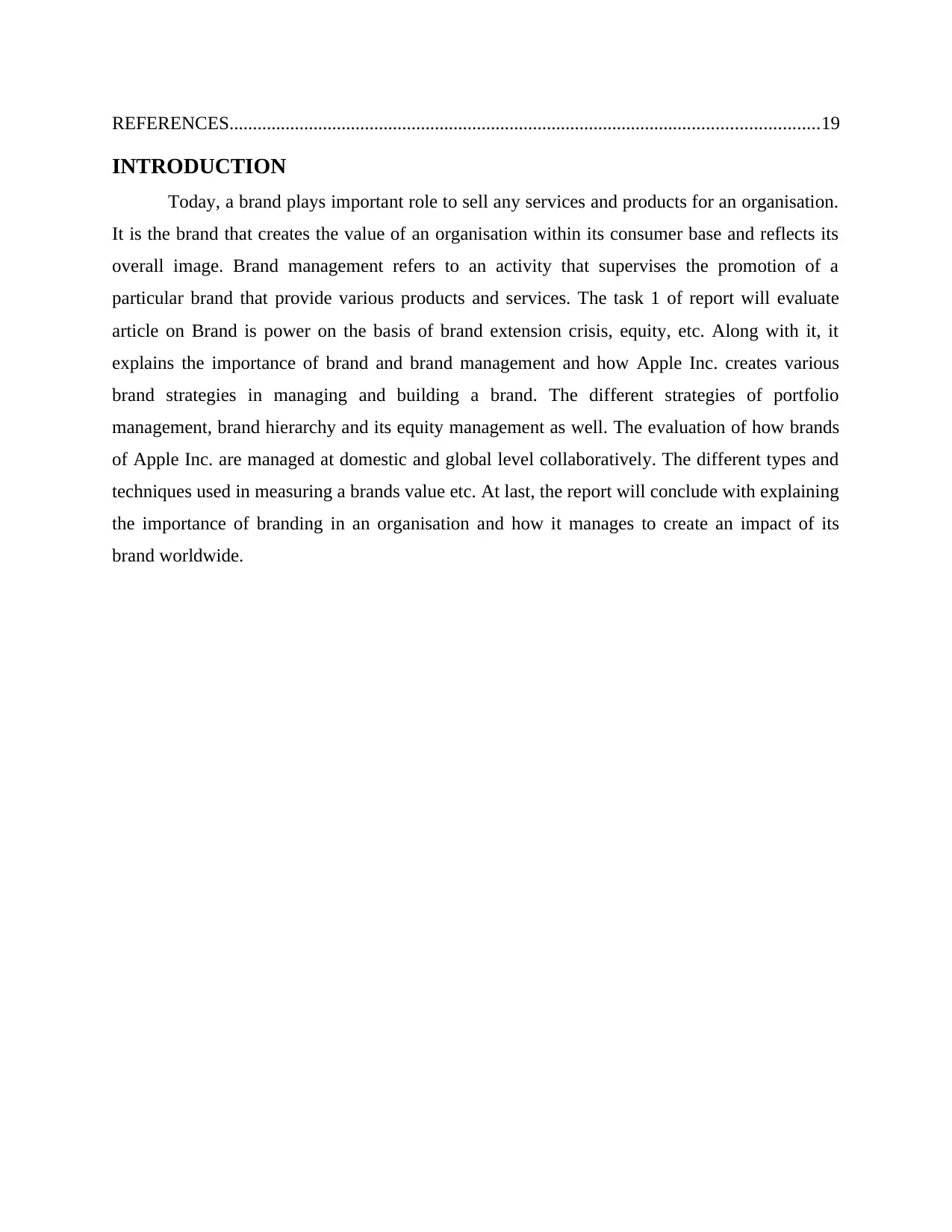
REFERENCES..............................................................................................................................19
INTRODUCTION
Today, a brand plays important role to sell any services and products for an organisation.
It is the brand that creates the value of an organisation within its consumer base and reflects its
overall image. Brand management refers to an activity that supervises the promotion of a
particular brand that provide various products and services. The task 1 of report will evaluate
article on Brand is power on the basis of brand extension crisis, equity, etc. Along with it, it
explains the importance of brand and brand management and how Apple Inc. creates various
brand strategies in managing and building a brand. The different strategies of portfolio
management, brand hierarchy and its equity management as well. The evaluation of how brands
of Apple Inc. are managed at domestic and global level collaboratively. The different types and
techniques used in measuring a brands value etc. At last, the report will conclude with explaining
the importance of branding in an organisation and how it manages to create an impact of its
brand worldwide.
INTRODUCTION
Today, a brand plays important role to sell any services and products for an organisation.
It is the brand that creates the value of an organisation within its consumer base and reflects its
overall image. Brand management refers to an activity that supervises the promotion of a
particular brand that provide various products and services. The task 1 of report will evaluate
article on Brand is power on the basis of brand extension crisis, equity, etc. Along with it, it
explains the importance of brand and brand management and how Apple Inc. creates various
brand strategies in managing and building a brand. The different strategies of portfolio
management, brand hierarchy and its equity management as well. The evaluation of how brands
of Apple Inc. are managed at domestic and global level collaboratively. The different types and
techniques used in measuring a brands value etc. At last, the report will conclude with explaining
the importance of branding in an organisation and how it manages to create an impact of its
brand worldwide.
⊘ This is a preview!⊘
Do you want full access?
Subscribe today to unlock all pages.

Trusted by 1+ million students worldwide

TASK 1
Paraphrase This Document
Need a fresh take? Get an instant paraphrase of this document with our AI Paraphraser
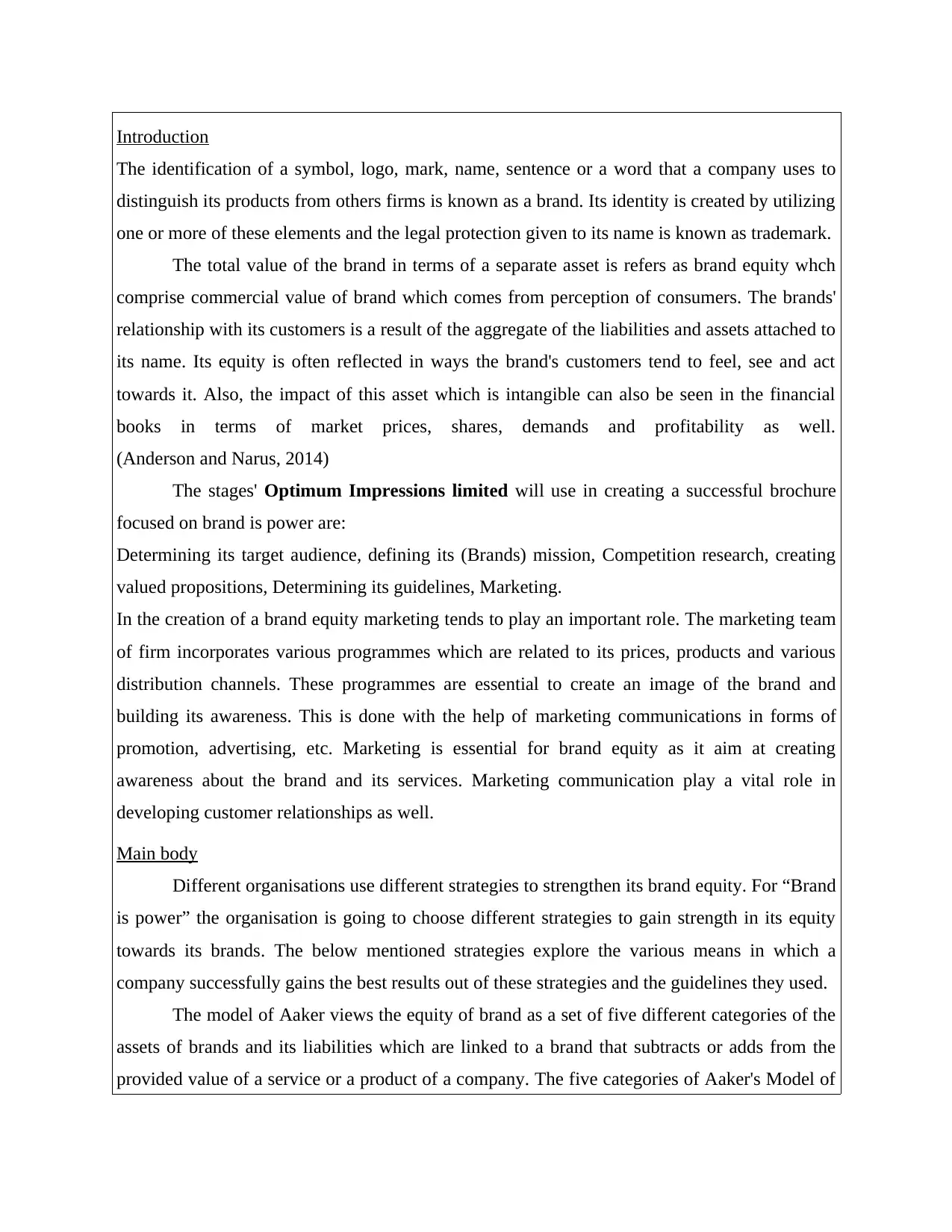
Introduction
The identification of a symbol, logo, mark, name, sentence or a word that a company uses to
distinguish its products from others firms is known as a brand. Its identity is created by utilizing
one or more of these elements and the legal protection given to its name is known as trademark.
The total value of the brand in terms of a separate asset is refers as brand equity whch
comprise commercial value of brand which comes from perception of consumers. The brands'
relationship with its customers is a result of the aggregate of the liabilities and assets attached to
its name. Its equity is often reflected in ways the brand's customers tend to feel, see and act
towards it. Also, the impact of this asset which is intangible can also be seen in the financial
books in terms of market prices, shares, demands and profitability as well.
(Anderson and Narus, 2014)
The stages' Optimum Impressions limited will use in creating a successful brochure
focused on brand is power are:
Determining its target audience, defining its (Brands) mission, Competition research, creating
valued propositions, Determining its guidelines, Marketing.
In the creation of a brand equity marketing tends to play an important role. The marketing team
of firm incorporates various programmes which are related to its prices, products and various
distribution channels. These programmes are essential to create an image of the brand and
building its awareness. This is done with the help of marketing communications in forms of
promotion, advertising, etc. Marketing is essential for brand equity as it aim at creating
awareness about the brand and its services. Marketing communication play a vital role in
developing customer relationships as well.
Main body
Different organisations use different strategies to strengthen its brand equity. For “Brand
is power” the organisation is going to choose different strategies to gain strength in its equity
towards its brands. The below mentioned strategies explore the various means in which a
company successfully gains the best results out of these strategies and the guidelines they used.
The model of Aaker views the equity of brand as a set of five different categories of the
assets of brands and its liabilities which are linked to a brand that subtracts or adds from the
provided value of a service or a product of a company. The five categories of Aaker's Model of
The identification of a symbol, logo, mark, name, sentence or a word that a company uses to
distinguish its products from others firms is known as a brand. Its identity is created by utilizing
one or more of these elements and the legal protection given to its name is known as trademark.
The total value of the brand in terms of a separate asset is refers as brand equity whch
comprise commercial value of brand which comes from perception of consumers. The brands'
relationship with its customers is a result of the aggregate of the liabilities and assets attached to
its name. Its equity is often reflected in ways the brand's customers tend to feel, see and act
towards it. Also, the impact of this asset which is intangible can also be seen in the financial
books in terms of market prices, shares, demands and profitability as well.
(Anderson and Narus, 2014)
The stages' Optimum Impressions limited will use in creating a successful brochure
focused on brand is power are:
Determining its target audience, defining its (Brands) mission, Competition research, creating
valued propositions, Determining its guidelines, Marketing.
In the creation of a brand equity marketing tends to play an important role. The marketing team
of firm incorporates various programmes which are related to its prices, products and various
distribution channels. These programmes are essential to create an image of the brand and
building its awareness. This is done with the help of marketing communications in forms of
promotion, advertising, etc. Marketing is essential for brand equity as it aim at creating
awareness about the brand and its services. Marketing communication play a vital role in
developing customer relationships as well.
Main body
Different organisations use different strategies to strengthen its brand equity. For “Brand
is power” the organisation is going to choose different strategies to gain strength in its equity
towards its brands. The below mentioned strategies explore the various means in which a
company successfully gains the best results out of these strategies and the guidelines they used.
The model of Aaker views the equity of brand as a set of five different categories of the
assets of brands and its liabilities which are linked to a brand that subtracts or adds from the
provided value of a service or a product of a company. The five categories of Aaker's Model of
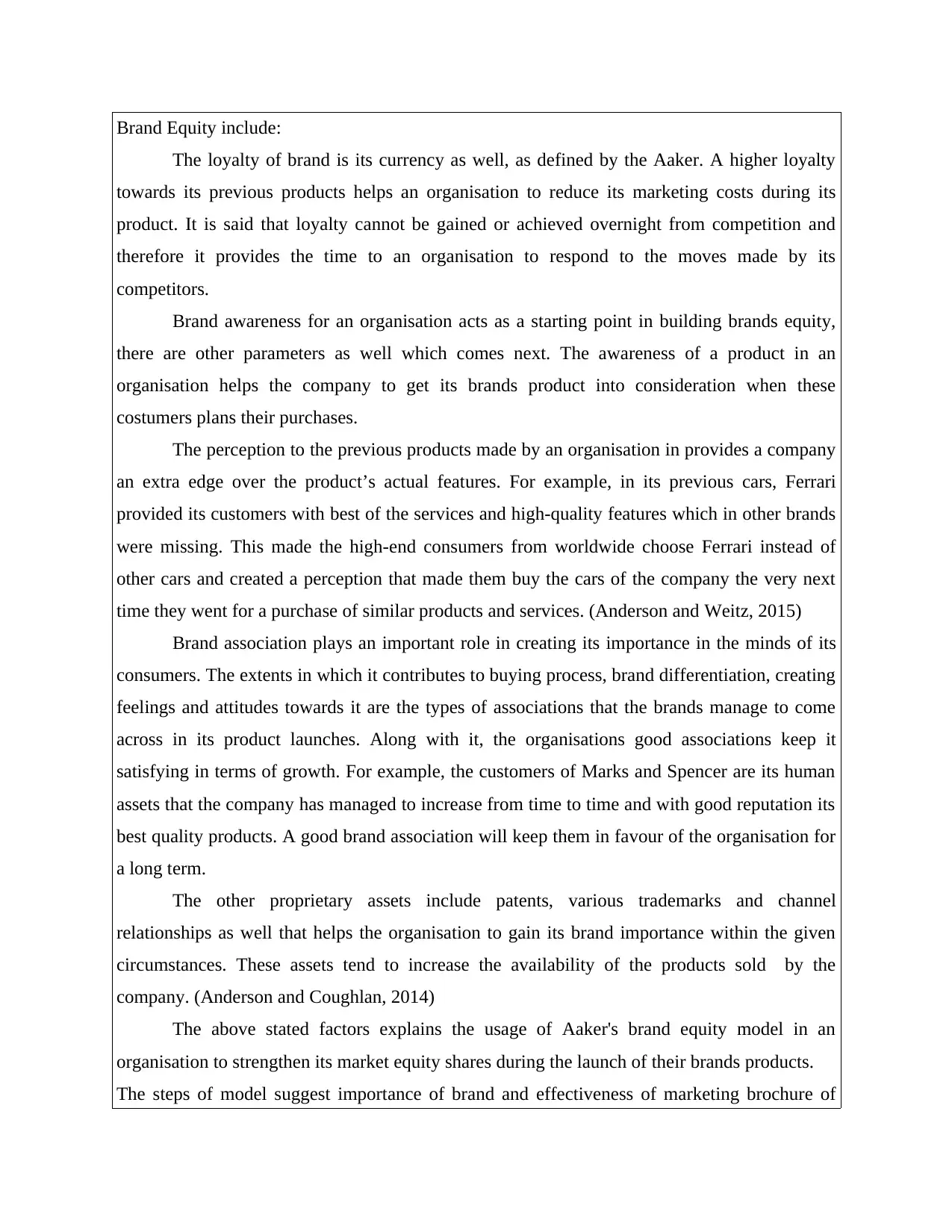
Brand Equity include:
The loyalty of brand is its currency as well, as defined by the Aaker. A higher loyalty
towards its previous products helps an organisation to reduce its marketing costs during its
product. It is said that loyalty cannot be gained or achieved overnight from competition and
therefore it provides the time to an organisation to respond to the moves made by its
competitors.
Brand awareness for an organisation acts as a starting point in building brands equity,
there are other parameters as well which comes next. The awareness of a product in an
organisation helps the company to get its brands product into consideration when these
costumers plans their purchases.
The perception to the previous products made by an organisation in provides a company
an extra edge over the product’s actual features. For example, in its previous cars, Ferrari
provided its customers with best of the services and high-quality features which in other brands
were missing. This made the high-end consumers from worldwide choose Ferrari instead of
other cars and created a perception that made them buy the cars of the company the very next
time they went for a purchase of similar products and services. (Anderson and Weitz, 2015)
Brand association plays an important role in creating its importance in the minds of its
consumers. The extents in which it contributes to buying process, brand differentiation, creating
feelings and attitudes towards it are the types of associations that the brands manage to come
across in its product launches. Along with it, the organisations good associations keep it
satisfying in terms of growth. For example, the customers of Marks and Spencer are its human
assets that the company has managed to increase from time to time and with good reputation its
best quality products. A good brand association will keep them in favour of the organisation for
a long term.
The other proprietary assets include patents, various trademarks and channel
relationships as well that helps the organisation to gain its brand importance within the given
circumstances. These assets tend to increase the availability of the products sold by the
company. (Anderson and Coughlan, 2014)
The above stated factors explains the usage of Aaker's brand equity model in an
organisation to strengthen its market equity shares during the launch of their brands products.
The steps of model suggest importance of brand and effectiveness of marketing brochure of
The loyalty of brand is its currency as well, as defined by the Aaker. A higher loyalty
towards its previous products helps an organisation to reduce its marketing costs during its
product. It is said that loyalty cannot be gained or achieved overnight from competition and
therefore it provides the time to an organisation to respond to the moves made by its
competitors.
Brand awareness for an organisation acts as a starting point in building brands equity,
there are other parameters as well which comes next. The awareness of a product in an
organisation helps the company to get its brands product into consideration when these
costumers plans their purchases.
The perception to the previous products made by an organisation in provides a company
an extra edge over the product’s actual features. For example, in its previous cars, Ferrari
provided its customers with best of the services and high-quality features which in other brands
were missing. This made the high-end consumers from worldwide choose Ferrari instead of
other cars and created a perception that made them buy the cars of the company the very next
time they went for a purchase of similar products and services. (Anderson and Weitz, 2015)
Brand association plays an important role in creating its importance in the minds of its
consumers. The extents in which it contributes to buying process, brand differentiation, creating
feelings and attitudes towards it are the types of associations that the brands manage to come
across in its product launches. Along with it, the organisations good associations keep it
satisfying in terms of growth. For example, the customers of Marks and Spencer are its human
assets that the company has managed to increase from time to time and with good reputation its
best quality products. A good brand association will keep them in favour of the organisation for
a long term.
The other proprietary assets include patents, various trademarks and channel
relationships as well that helps the organisation to gain its brand importance within the given
circumstances. These assets tend to increase the availability of the products sold by the
company. (Anderson and Coughlan, 2014)
The above stated factors explains the usage of Aaker's brand equity model in an
organisation to strengthen its market equity shares during the launch of their brands products.
The steps of model suggest importance of brand and effectiveness of marketing brochure of
⊘ This is a preview!⊘
Do you want full access?
Subscribe today to unlock all pages.

Trusted by 1+ million students worldwide
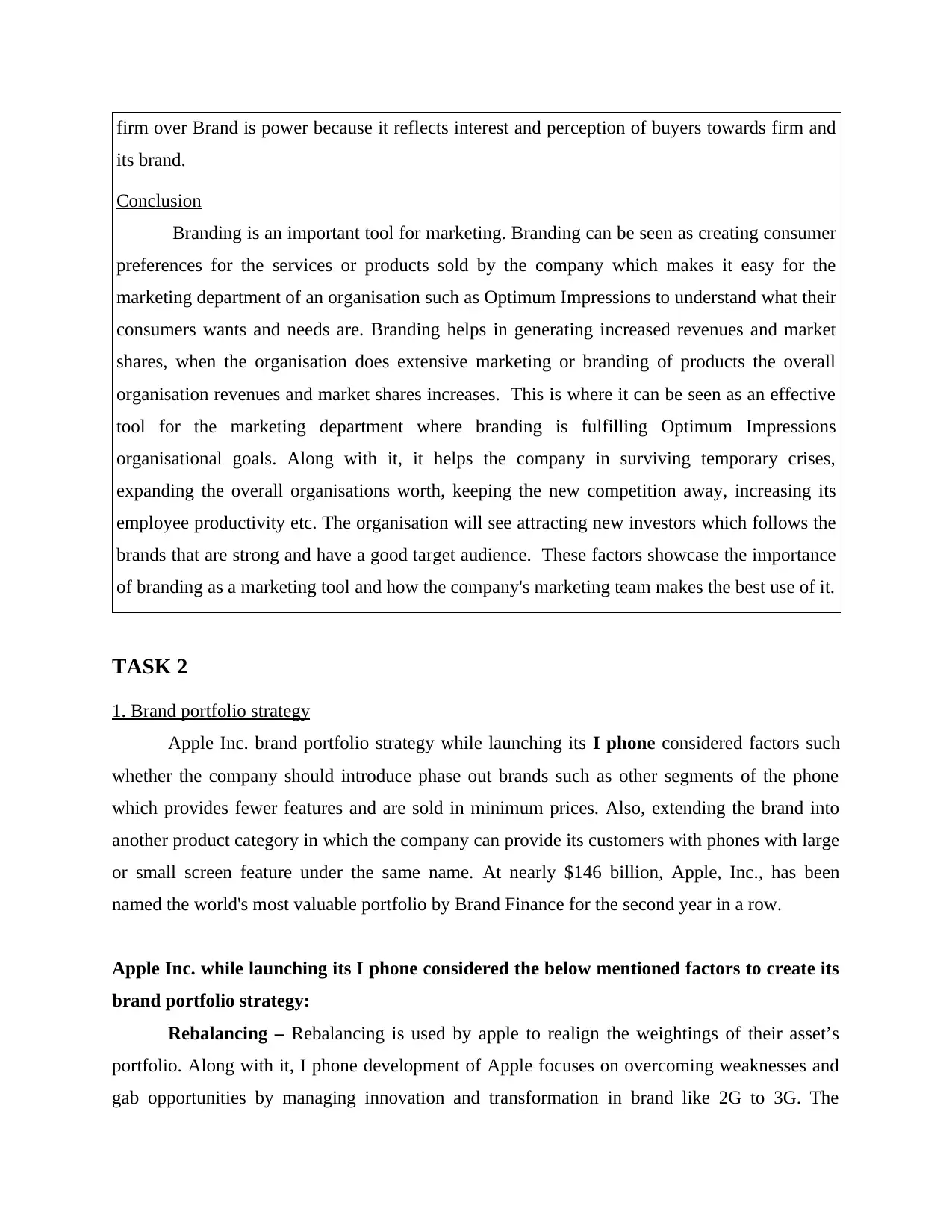
firm over Brand is power because it reflects interest and perception of buyers towards firm and
its brand.
Conclusion
Branding is an important tool for marketing. Branding can be seen as creating consumer
preferences for the services or products sold by the company which makes it easy for the
marketing department of an organisation such as Optimum Impressions to understand what their
consumers wants and needs are. Branding helps in generating increased revenues and market
shares, when the organisation does extensive marketing or branding of products the overall
organisation revenues and market shares increases. This is where it can be seen as an effective
tool for the marketing department where branding is fulfilling Optimum Impressions
organisational goals. Along with it, it helps the company in surviving temporary crises,
expanding the overall organisations worth, keeping the new competition away, increasing its
employee productivity etc. The organisation will see attracting new investors which follows the
brands that are strong and have a good target audience. These factors showcase the importance
of branding as a marketing tool and how the company's marketing team makes the best use of it.
TASK 2
1. Brand portfolio strategy
Apple Inc. brand portfolio strategy while launching its I phone considered factors such
whether the company should introduce phase out brands such as other segments of the phone
which provides fewer features and are sold in minimum prices. Also, extending the brand into
another product category in which the company can provide its customers with phones with large
or small screen feature under the same name. At nearly $146 billion, Apple, Inc., has been
named the world's most valuable portfolio by Brand Finance for the second year in a row.
Apple Inc. while launching its I phone considered the below mentioned factors to create its
brand portfolio strategy:
Rebalancing – Rebalancing is used by apple to realign the weightings of their asset’s
portfolio. Along with it, I phone development of Apple focuses on overcoming weaknesses and
gab opportunities by managing innovation and transformation in brand like 2G to 3G. The
its brand.
Conclusion
Branding is an important tool for marketing. Branding can be seen as creating consumer
preferences for the services or products sold by the company which makes it easy for the
marketing department of an organisation such as Optimum Impressions to understand what their
consumers wants and needs are. Branding helps in generating increased revenues and market
shares, when the organisation does extensive marketing or branding of products the overall
organisation revenues and market shares increases. This is where it can be seen as an effective
tool for the marketing department where branding is fulfilling Optimum Impressions
organisational goals. Along with it, it helps the company in surviving temporary crises,
expanding the overall organisations worth, keeping the new competition away, increasing its
employee productivity etc. The organisation will see attracting new investors which follows the
brands that are strong and have a good target audience. These factors showcase the importance
of branding as a marketing tool and how the company's marketing team makes the best use of it.
TASK 2
1. Brand portfolio strategy
Apple Inc. brand portfolio strategy while launching its I phone considered factors such
whether the company should introduce phase out brands such as other segments of the phone
which provides fewer features and are sold in minimum prices. Also, extending the brand into
another product category in which the company can provide its customers with phones with large
or small screen feature under the same name. At nearly $146 billion, Apple, Inc., has been
named the world's most valuable portfolio by Brand Finance for the second year in a row.
Apple Inc. while launching its I phone considered the below mentioned factors to create its
brand portfolio strategy:
Rebalancing – Rebalancing is used by apple to realign the weightings of their asset’s
portfolio. Along with it, I phone development of Apple focuses on overcoming weaknesses and
gab opportunities by managing innovation and transformation in brand like 2G to 3G. The
Paraphrase This Document
Need a fresh take? Get an instant paraphrase of this document with our AI Paraphraser
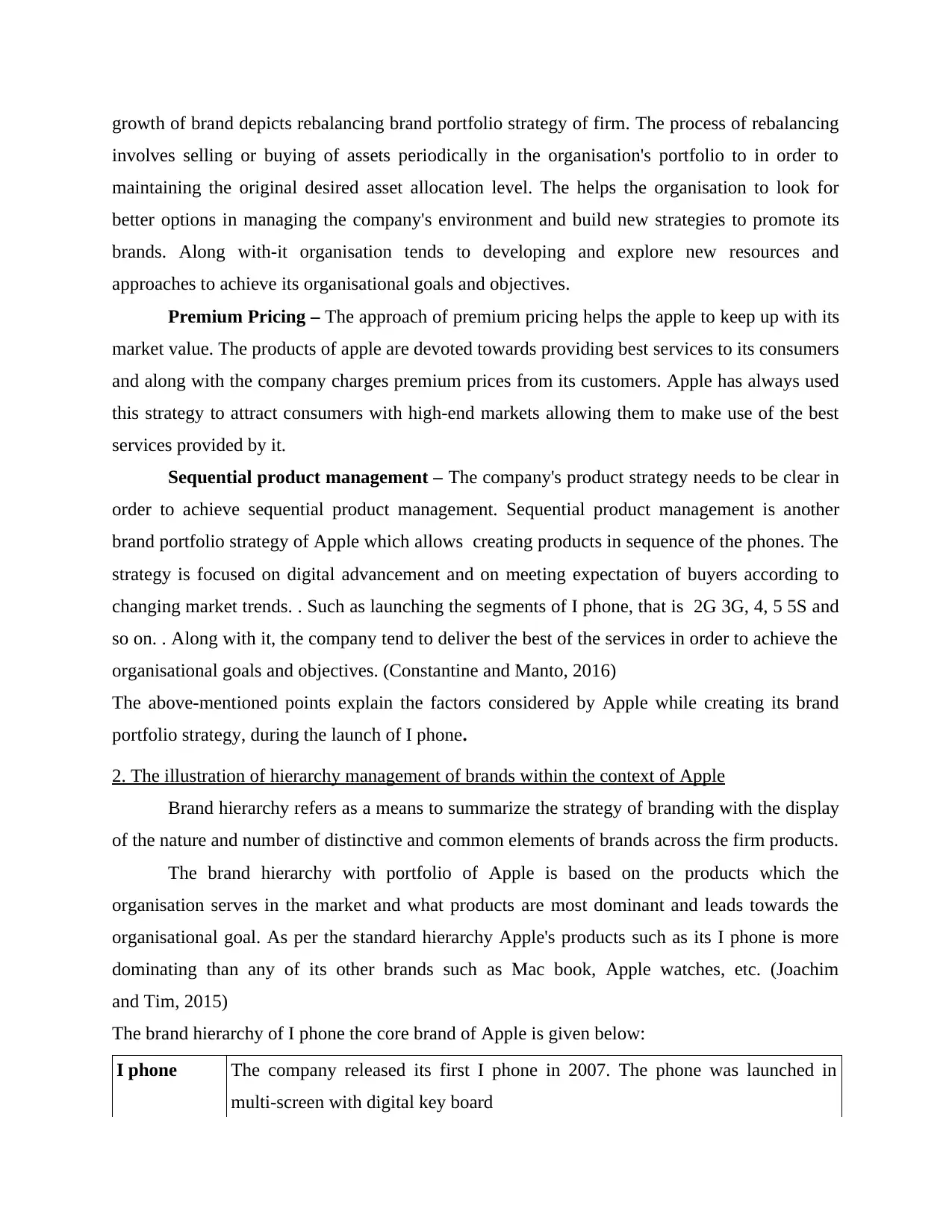
growth of brand depicts rebalancing brand portfolio strategy of firm. The process of rebalancing
involves selling or buying of assets periodically in the organisation's portfolio to in order to
maintaining the original desired asset allocation level. The helps the organisation to look for
better options in managing the company's environment and build new strategies to promote its
brands. Along with-it organisation tends to developing and explore new resources and
approaches to achieve its organisational goals and objectives.
Premium Pricing – The approach of premium pricing helps the apple to keep up with its
market value. The products of apple are devoted towards providing best services to its consumers
and along with the company charges premium prices from its customers. Apple has always used
this strategy to attract consumers with high-end markets allowing them to make use of the best
services provided by it.
Sequential product management – The company's product strategy needs to be clear in
order to achieve sequential product management. Sequential product management is another
brand portfolio strategy of Apple which allows creating products in sequence of the phones. The
strategy is focused on digital advancement and on meeting expectation of buyers according to
changing market trends. . Such as launching the segments of I phone, that is 2G 3G, 4, 5 5S and
so on. . Along with it, the company tend to deliver the best of the services in order to achieve the
organisational goals and objectives. (Constantine and Manto, 2016)
The above-mentioned points explain the factors considered by Apple while creating its brand
portfolio strategy, during the launch of I phone.
2. The illustration of hierarchy management of brands within the context of Apple
Brand hierarchy refers as a means to summarize the strategy of branding with the display
of the nature and number of distinctive and common elements of brands across the firm products.
The brand hierarchy with portfolio of Apple is based on the products which the
organisation serves in the market and what products are most dominant and leads towards the
organisational goal. As per the standard hierarchy Apple's products such as its I phone is more
dominating than any of its other brands such as Mac book, Apple watches, etc. (Joachim
and Tim, 2015)
The brand hierarchy of I phone the core brand of Apple is given below:
I phone The company released its first I phone in 2007. The phone was launched in
multi-screen with digital key board
involves selling or buying of assets periodically in the organisation's portfolio to in order to
maintaining the original desired asset allocation level. The helps the organisation to look for
better options in managing the company's environment and build new strategies to promote its
brands. Along with-it organisation tends to developing and explore new resources and
approaches to achieve its organisational goals and objectives.
Premium Pricing – The approach of premium pricing helps the apple to keep up with its
market value. The products of apple are devoted towards providing best services to its consumers
and along with the company charges premium prices from its customers. Apple has always used
this strategy to attract consumers with high-end markets allowing them to make use of the best
services provided by it.
Sequential product management – The company's product strategy needs to be clear in
order to achieve sequential product management. Sequential product management is another
brand portfolio strategy of Apple which allows creating products in sequence of the phones. The
strategy is focused on digital advancement and on meeting expectation of buyers according to
changing market trends. . Such as launching the segments of I phone, that is 2G 3G, 4, 5 5S and
so on. . Along with it, the company tend to deliver the best of the services in order to achieve the
organisational goals and objectives. (Constantine and Manto, 2016)
The above-mentioned points explain the factors considered by Apple while creating its brand
portfolio strategy, during the launch of I phone.
2. The illustration of hierarchy management of brands within the context of Apple
Brand hierarchy refers as a means to summarize the strategy of branding with the display
of the nature and number of distinctive and common elements of brands across the firm products.
The brand hierarchy with portfolio of Apple is based on the products which the
organisation serves in the market and what products are most dominant and leads towards the
organisational goal. As per the standard hierarchy Apple's products such as its I phone is more
dominating than any of its other brands such as Mac book, Apple watches, etc. (Joachim
and Tim, 2015)
The brand hierarchy of I phone the core brand of Apple is given below:
I phone The company released its first I phone in 2007. The phone was launched in
multi-screen with digital key board
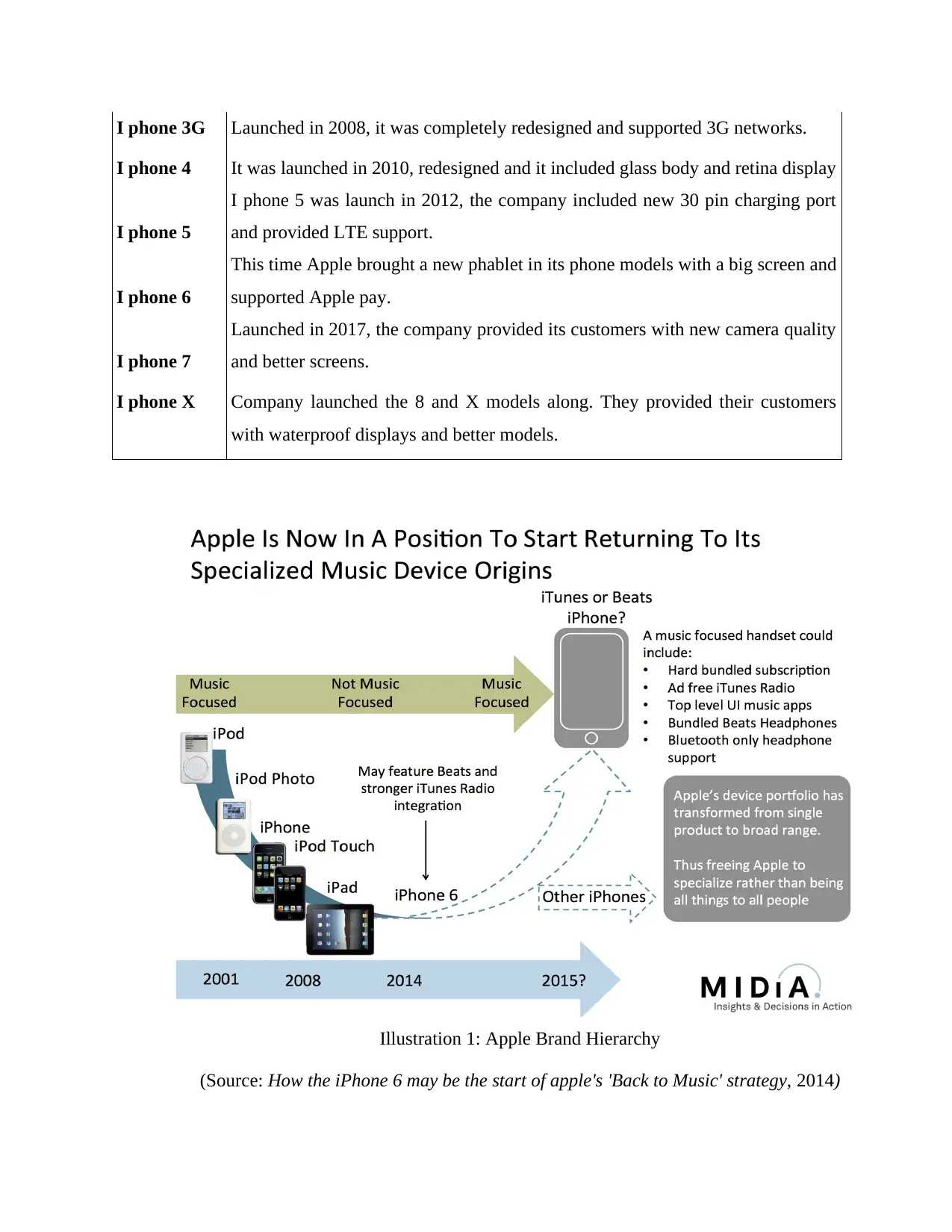
I phone 3G Launched in 2008, it was completely redesigned and supported 3G networks.
I phone 4
I phone 5
I phone 6
I phone 7
It was launched in 2010, redesigned and it included glass body and retina display
I phone 5 was launch in 2012, the company included new 30 pin charging port
and provided LTE support.
This time Apple brought a new phablet in its phone models with a big screen and
supported Apple pay.
Launched in 2017, the company provided its customers with new camera quality
and better screens.
I phone X Company launched the 8 and X models along. They provided their customers
with waterproof displays and better models.
Illustration 1: Apple Brand Hierarchy
(Source: How the iPhone 6 may be the start of apple's 'Back to Music' strategy, 2014)
I phone 4
I phone 5
I phone 6
I phone 7
It was launched in 2010, redesigned and it included glass body and retina display
I phone 5 was launch in 2012, the company included new 30 pin charging port
and provided LTE support.
This time Apple brought a new phablet in its phone models with a big screen and
supported Apple pay.
Launched in 2017, the company provided its customers with new camera quality
and better screens.
I phone X Company launched the 8 and X models along. They provided their customers
with waterproof displays and better models.
Illustration 1: Apple Brand Hierarchy
(Source: How the iPhone 6 may be the start of apple's 'Back to Music' strategy, 2014)
⊘ This is a preview!⊘
Do you want full access?
Subscribe today to unlock all pages.

Trusted by 1+ million students worldwide

Hierarchy management of Brand
There are two main models which are used to manage and organize brand portfolio.
These are house of brands or branded houses.
Branded House
It is one of the most common forms of brand portfolio. Apple when marketing itself as a
branded house expresses value proposition in unified and a single voice. In this strategy the
master brand structure is characterised by only one and single brand name where individual
products are aligned under the corporate entity. Here, the organisation itself is the brand and the
umbrella brands or brands are the products marketed by using the name of a brand name that
holds the parentage of all these brands. Apple uses this strategy in the organisation. For
example: Its products and services such as I phone, I music, I cloud, I watch, I pad etc. are its
line extensions and are known as the parent brand name.
Advantages
Its advantage include competition and confusion are avoided from keeping every
marketing strategy, budget, offering under the same brand.
The brand does not require a lot of promotion as a single promotion strategy tend to make
each of the brand successful.
Disadvantages
A bad reputation gained by the single product can make the overall brand suffer.
There are two main models which are used to manage and organize brand portfolio.
These are house of brands or branded houses.
Branded House
It is one of the most common forms of brand portfolio. Apple when marketing itself as a
branded house expresses value proposition in unified and a single voice. In this strategy the
master brand structure is characterised by only one and single brand name where individual
products are aligned under the corporate entity. Here, the organisation itself is the brand and the
umbrella brands or brands are the products marketed by using the name of a brand name that
holds the parentage of all these brands. Apple uses this strategy in the organisation. For
example: Its products and services such as I phone, I music, I cloud, I watch, I pad etc. are its
line extensions and are known as the parent brand name.
Advantages
Its advantage include competition and confusion are avoided from keeping every
marketing strategy, budget, offering under the same brand.
The brand does not require a lot of promotion as a single promotion strategy tend to make
each of the brand successful.
Disadvantages
A bad reputation gained by the single product can make the overall brand suffer.
Paraphrase This Document
Need a fresh take? Get an instant paraphrase of this document with our AI Paraphraser

(Source: Branded House or House of Brands, 2016)
House of Brands
This strategy is complete opposite from the Branded house. At this place sub-brands are
promoted or featured rather than corporate brands of Apple itself. The hierarchy occurring within
the company are more complex and an amalgamation of different products or services. There is
no need to create any leverage or awareness from the parent brand name. Apple is known for the
house of brand as they have introduced a line of product which is known by an individual name
of the brand and a single product line. For example: I phone, I pad. I watch are marketed by
Apple itself and holds the brands own identity. The products are marketed and sold understand
house of brands and the profits gained are earned by same entity.
Advantages
The advantage provided by House of Brands to apple is that it provides it an ability of each sub
brand in order to define target audience in a much wider demographic range.
Disadvantage
It is very costly in House of Brands to implement, develop and operate many products
and service line and implement a successful marketing strategy.
3. Strategies to maximise brand equity
Apple strategy to maximizing brand equity. The brand pyramid of Apple aims at:
Illustration 2: House of Brands : APPLE
House of Brands
This strategy is complete opposite from the Branded house. At this place sub-brands are
promoted or featured rather than corporate brands of Apple itself. The hierarchy occurring within
the company are more complex and an amalgamation of different products or services. There is
no need to create any leverage or awareness from the parent brand name. Apple is known for the
house of brand as they have introduced a line of product which is known by an individual name
of the brand and a single product line. For example: I phone, I pad. I watch are marketed by
Apple itself and holds the brands own identity. The products are marketed and sold understand
house of brands and the profits gained are earned by same entity.
Advantages
The advantage provided by House of Brands to apple is that it provides it an ability of each sub
brand in order to define target audience in a much wider demographic range.
Disadvantage
It is very costly in House of Brands to implement, develop and operate many products
and service line and implement a successful marketing strategy.
3. Strategies to maximise brand equity
Apple strategy to maximizing brand equity. The brand pyramid of Apple aims at:
Illustration 2: House of Brands : APPLE
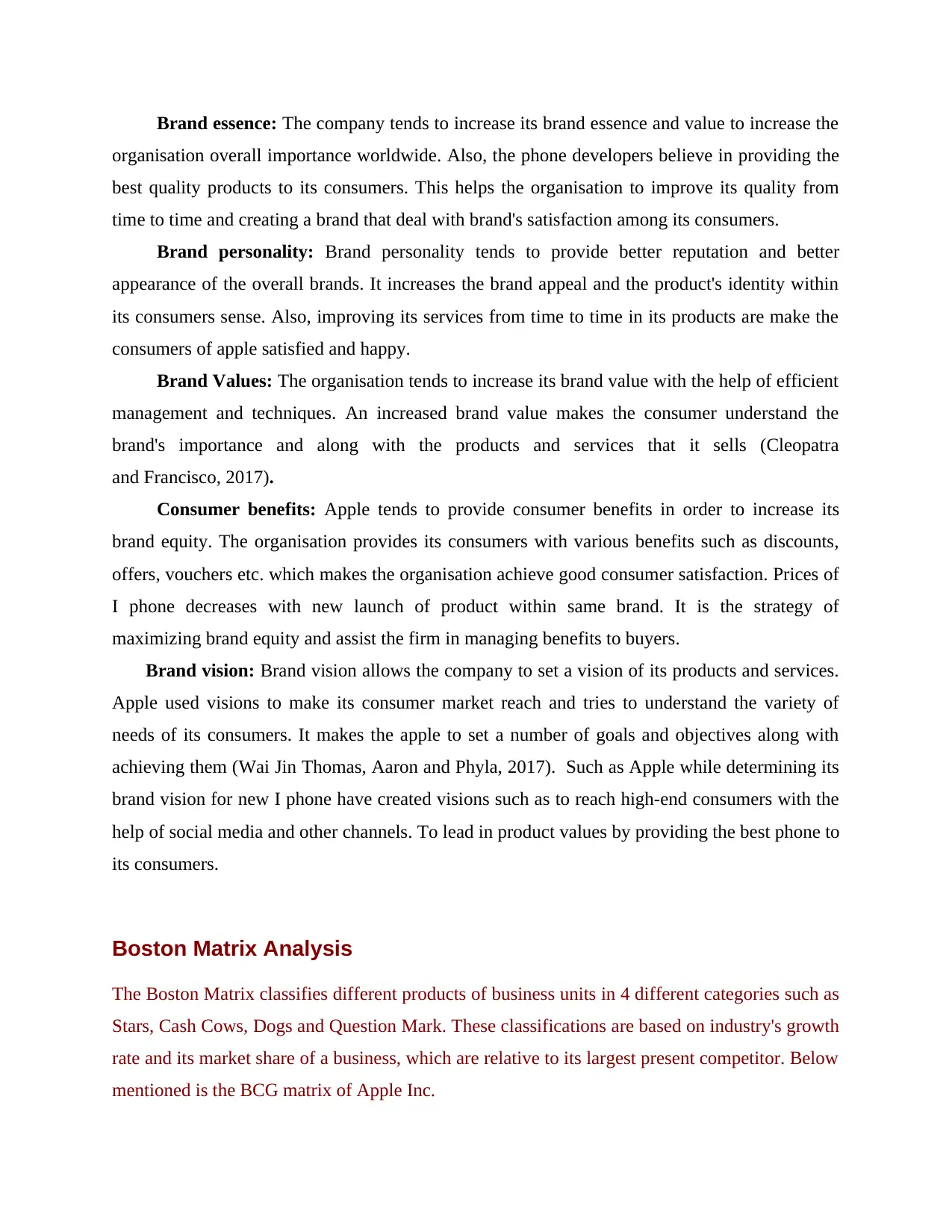
Brand essence: The company tends to increase its brand essence and value to increase the
organisation overall importance worldwide. Also, the phone developers believe in providing the
best quality products to its consumers. This helps the organisation to improve its quality from
time to time and creating a brand that deal with brand's satisfaction among its consumers.
Brand personality: Brand personality tends to provide better reputation and better
appearance of the overall brands. It increases the brand appeal and the product's identity within
its consumers sense. Also, improving its services from time to time in its products are make the
consumers of apple satisfied and happy.
Brand Values: The organisation tends to increase its brand value with the help of efficient
management and techniques. An increased brand value makes the consumer understand the
brand's importance and along with the products and services that it sells (Cleopatra
and Francisco, 2017).
Consumer benefits: Apple tends to provide consumer benefits in order to increase its
brand equity. The organisation provides its consumers with various benefits such as discounts,
offers, vouchers etc. which makes the organisation achieve good consumer satisfaction. Prices of
I phone decreases with new launch of product within same brand. It is the strategy of
maximizing brand equity and assist the firm in managing benefits to buyers.
Brand vision: Brand vision allows the company to set a vision of its products and services.
Apple used visions to make its consumer market reach and tries to understand the variety of
needs of its consumers. It makes the apple to set a number of goals and objectives along with
achieving them (Wai Jin Thomas, Aaron and Phyla, 2017). Such as Apple while determining its
brand vision for new I phone have created visions such as to reach high-end consumers with the
help of social media and other channels. To lead in product values by providing the best phone to
its consumers.
Boston Matrix Analysis
The Boston Matrix classifies different products of business units in 4 different categories such as
Stars, Cash Cows, Dogs and Question Mark. These classifications are based on industry's growth
rate and its market share of a business, which are relative to its largest present competitor. Below
mentioned is the BCG matrix of Apple Inc.
organisation overall importance worldwide. Also, the phone developers believe in providing the
best quality products to its consumers. This helps the organisation to improve its quality from
time to time and creating a brand that deal with brand's satisfaction among its consumers.
Brand personality: Brand personality tends to provide better reputation and better
appearance of the overall brands. It increases the brand appeal and the product's identity within
its consumers sense. Also, improving its services from time to time in its products are make the
consumers of apple satisfied and happy.
Brand Values: The organisation tends to increase its brand value with the help of efficient
management and techniques. An increased brand value makes the consumer understand the
brand's importance and along with the products and services that it sells (Cleopatra
and Francisco, 2017).
Consumer benefits: Apple tends to provide consumer benefits in order to increase its
brand equity. The organisation provides its consumers with various benefits such as discounts,
offers, vouchers etc. which makes the organisation achieve good consumer satisfaction. Prices of
I phone decreases with new launch of product within same brand. It is the strategy of
maximizing brand equity and assist the firm in managing benefits to buyers.
Brand vision: Brand vision allows the company to set a vision of its products and services.
Apple used visions to make its consumer market reach and tries to understand the variety of
needs of its consumers. It makes the apple to set a number of goals and objectives along with
achieving them (Wai Jin Thomas, Aaron and Phyla, 2017). Such as Apple while determining its
brand vision for new I phone have created visions such as to reach high-end consumers with the
help of social media and other channels. To lead in product values by providing the best phone to
its consumers.
Boston Matrix Analysis
The Boston Matrix classifies different products of business units in 4 different categories such as
Stars, Cash Cows, Dogs and Question Mark. These classifications are based on industry's growth
rate and its market share of a business, which are relative to its largest present competitor. Below
mentioned is the BCG matrix of Apple Inc.
⊘ This is a preview!⊘
Do you want full access?
Subscribe today to unlock all pages.

Trusted by 1+ million students worldwide
1 out of 23
Related Documents
Your All-in-One AI-Powered Toolkit for Academic Success.
+13062052269
info@desklib.com
Available 24*7 on WhatsApp / Email
![[object Object]](/_next/static/media/star-bottom.7253800d.svg)
Unlock your academic potential
Copyright © 2020–2025 A2Z Services. All Rights Reserved. Developed and managed by ZUCOL.



